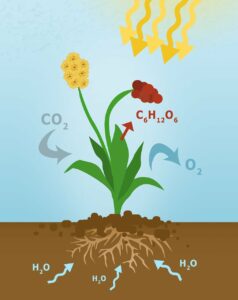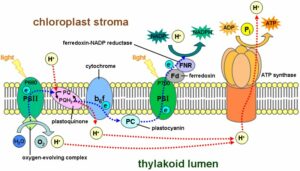Photosynthesis is a unique and complex mechanism in which the photosynthetic organisms prepare their food for survival; one of them is the light independent reaction.
In this article we will see the complex reaction and the light independent reaction example:
- Photosynthetic light independent reaction or the light independent reaction of photosynthesis
- Calvin Cycle
- Calvin-Benson Cycle
- Dark Reactions
Photosynthesis is a process in which the photosynthetic organism captures the solar energy from the sun and the atmospheric carbon- di- oxide and water present in the earth ground to produce oxygen molecules and energy molecules for survival.

Image Credits- Pixabay
So, What is exactly a light independent reaction?
There are many complex reactions happening in every living organism and their requirements are different.
In photosynthesis, there are 2 processes.
- Light- dependent process
- Light- Independent process
Light dependent is a process in which the photosynthetic organism uses light to produce certain essential products.
Light independent reaction is a complex reaction taking place in photosynthetic organisms that do not require light or happens in the absence of light.
Read More on Is Cyanobacteria Unicellular Or Multicellular: Why, How And Detailed Insights
This light independent photosynthetic reaction is a follow up process of the light dependent reaction, as the products of light dependent reaction such as NADPH (Nicotinamide Adenine Dinucleotide Phosphate) and ATP (Adenosine Triphosphate) are used to prepare the energy molecules like glucose and carbohydrate molecules.
Read More on Why chromosomes are in pairs: comparative analysis on structure, function and facts.
Photosynthetic Light Independent Reaction or the Light Independent Reaction of photosynthesis:
- The Photosynthetic Light Independent Reaction happens in the organelle chloroplast in the stroma region.
- Here they react with NADPH (Nicotinamide Adenine Dinucleotide Phosphate) and ATP (Adenosine Triphosphate) along with certain enzymes.
- Thus leading to the formation of the carbon molecules such as glucose from the atmospheric carbon- di- oxide.
- The photosynthetic Light Independent Reaction or the Light Independent Reaction of photosynthesis is also called the light reaction of photosynthesis or the photosynthetic photoreaction process.
Read More on Difference between animal and plant cell chromosomes: Comparative analysis on structure, function and facts
Calvin Cycle:
- From the light-dependent reactions the solar energy that is obtained from the sun is used and NADPH (Nicotinamide Adenine Dinucleotide Phosphate) and ATP (Adenosine Triphosphate) molecules are produced.
- Now, this NADPH (Nicotinamide Adenine Dinucleotide Phosphate) and ATP (Adenosine Triphosphate) molecules are used as the fuel in the light-independent reactions to form carbohydrate molecules or to be more precise- glucose molecules.
- The carbohydrate molecules or the glucose molecules need carbon atoms to produce energy and this carbon they get from the atmospheric carbon dioxide present in the environment.
- The process involves- diffusion of the atmospheric carbon- di- oxide into the stomata of the photosynthetic organisms.
- So this calvin cycle or the light independent reaction process is a sequence of reactions that happens after the light dependent process as they end products of the light dependent process- NADPH (Nicotinamide Adenine Dinucleotide Phosphate) and ATP (Adenosine Triphosphate) are used to make glucose (carbohydrate) molecules.

Image Credits- Flickr
Read More on Are Bacteria Prokaryotic Or Eukaryotic: Why, How And Detailed Insights And Facts
The Calvin-Benson Cycle:
- The Calvin-Benson Cycle is also known as the Calvin cycle.
- The calvin cycle is the only preferred term used all over the world but still there are many synonyms for the calvin cycle.
- The other terms of the Calvin cycle are Calvin-Benson Cycle, Benson-Calvin Cycle, and the Calvin-Benson-Bassham Cycle.
Read More on Sequence Of Nitrogenous Bases In RNA: What, Why, Purpose, Detailed Facts
The Dark Reaction:
- From the name, we can conclude that this reaction does not require light and happens only in dark- Dark reaction.
- Apart from photosynthesis, there is another process called the photorespiration which happens simultaneously.
- There are three phases of dark reaction which is the fixation of carbon, reduction of carbon, regeneration of RuBp-Ribulose 1,5-bisphosphate.
Also Read:
- Function of flagella
- Do bacteria form endospores
- Animal chromosomes structure
- Passive transport examples
- Archaea cell membrane and bacteria cell membrane
- Is cyanobacteria unicellular or multicellular
- Marine algae example
- Compound fruit examples
- Dispersive dna replication
- Scorpion characteristics

Hello, I am Sugaprabha Prasath, a Postgraduate in the field of Microbiology. I am an active member of the Indian association of applied microbiology (IAAM). I have research experience in preclinical (Zebrafish), bacterial enzymology, and nanotechnology. I have published 2 research articles in an International journal and a few more are yet to be published, 2 sequences were submitted to NCBI-GENBANK. I am good at clearly explaining the concepts in biology at both basic and advanced levels. My area of specialization is biotechnology, microbiology, enzymology, molecular biology, and pharmacovigilance. Apart from academics, I love gardening and being with plants and animals.
My LinkedIn profile-